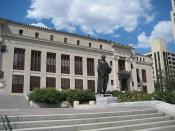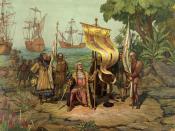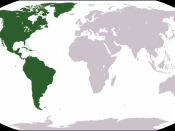Christopher Columbus first discovered the Americas while trying to prove his theory that Europeans could reach China by sailing west from Europe. After years of study, he approached the rulers of several European countries to fund his exploration. Spain's King Ferdinand and Queen Isabella agreed to fund the voyage and in August of 1492, Columbus set sail from the Spanish port of Palos with three ships and 88 men. Columbus described this first voyage to the Americas in his ship's log, which proves evidence of the clashing of ideology of the Indians he finds there and the Western Europeans of the fifteenth century.
James H. Kavanagh says of ideology, "in order even to assure the continuity of its mode of producing material wealth, every society must first assure the reproduction of these class relations themselves." There were four such important ideologies Columbus and his crew brought to the Americas: an economic ideology; racism; Christianity; and an ideology of imperialism (308).
By 1492, the Age of Exploration had begun in Europe and people were willing to risk their lives for God, glory, and gold. Columbus is one of those such people who fully believed that he could profit from the discovery of a western water route to Asia. With the financial backing he received from Spain he is able to set sail toward the west. In October 1492, Columbus lands in the America's where he is greeted by the native people, whom he refers to as Indians, because he thinks he landed on islands near Asia. Somewhat fascinated by these people Columbus never forgets his main goals and claims the island for the nation of Spain and begins to inquire about gold: "I was attentive to find out if there was any gold; and I saw that some of them wore...


